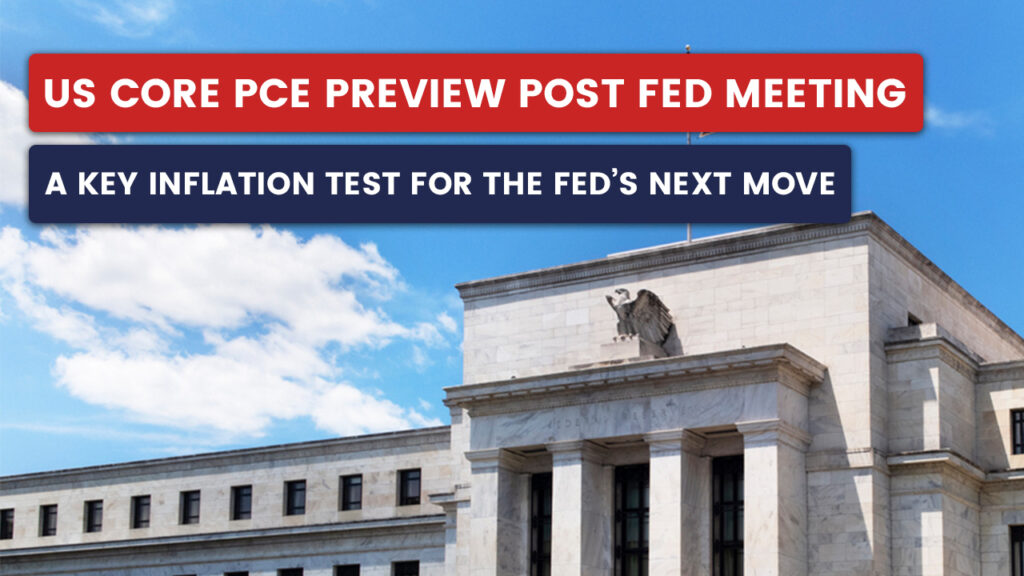US Core PCE Preview Post Fed Meeting: A Key Inflation Test for the Fed’s Next Move
Article published on January 31st, 2025 6:30AM UK Time

The upcoming Core PCE inflation print on Friday is shaping up to be a pivotal moment for markets, coming on the heels of a Fed meeting that initially leaned hawkish but ultimately failed to sustain gains for the dollar or US yields. While Powell reaffirmed the Fed’s data-dependent stance, the market is currently pricing in two 25bps cuts this year—one in June and another in December. That leaves upcoming inflation data, as well as the evolving trade policy landscape, as the next major catalysts for rate expectations.
The Fed’s Inflation Dilemma
Powell’s messaging at the FOMC press conference reinforced a delicate balancing act: moving too quickly on rate cuts could undermine inflation progress, while delaying too long might dampen employment. He confirmed that policy remains restrictive but reiterated that the Fed doesn’t need to see inflation at 2% before considering cuts. However, with the central bank emphasizing its dual mandate of stable prices and maximum employment, any sign of sticky inflation in the PCE report could extend the current higher-for-longer narrative.
Market Expectations and Reaction Scenarios
The PCE report—widely considered the Fed’s preferred inflation gauge—will be critical in shaping near-term policy bets. The base case expectation is for Core PCE to remain stable, with a month-on-month increase of 0.2% and a year-on-year reading of 2.8-2.9%.
Hotter-Than-Expected Print (0.3%+ MoM, 3.0%+ YoY)
If PCE inflation comes in above expectations—say at 0.3% MoM or higher and 3.0% YoY or higher—markets will likely interpret this as a sign that inflation pressures remain persistent, reinforcing the Fed’s cautious stance. The result:
- Stronger USD: A hotter print would lead to a repricing of Fed rate expectations, with fewer cuts priced in for 2024. The dollar would strengthen, particularly against lower-yielding currencies.
- Equity Selloff: The S&P 500 could see downside, as higher inflation reduces the likelihood of near-term policy easing. Tech-heavy growth stocks, which have been particularly sensitive to rate expectations, could face selling pressure.
- Higher Yields: A strong inflation reading would lead to a selloff in US Treasuries, pushing yields higher, particularly at the front end of the curve.
Softer-Than-Expected Print (0.1% MoM or lower, 2.6% YoY or lower)
A weaker PCE print—especially if Core PCE MoM lands at 0.1% or below—would strengthen the case for earlier rate cuts and reinforce the dovish Fed bets that have already taken hold. The result:
- USD Weakness: A softer inflation reading would likely send the dollar lower, particularly against the euro and other risk-sensitive currencies.
- Stock Market Rally: Equities, especially rate-sensitive sectors like tech, would likely see a move higher as expectations for a June rate cut become more entrenched.
- Lower Treasury Yields: A weaker inflation read would drive bond-buying, sending US Treasury yields lower as markets price in an increased likelihood of earlier rate cuts.
Why This Print Matters More Than the FOMC Meeting
While the Fed meeting itself was largely a placeholder event, Powell’s cautious yet flexible tone has set the stage for data to drive market expectations. A hotter print could bring back hawkish Fed bets and weigh on risk assets, while a softer number could allow markets to continue pushing the “peak rates are behind us” narrative.
Moreover, with markets already leaning dovish—pricing in two full cuts this year—it would take an out-of-consensus upside surprise to meaningfully shift expectations toward a more hawkish stance. At the same time, weak inflation data would reinforce the easing trajectory, making this print a key inflection point for near-term rate expectations.
Bottom Line
The PCE inflation data on Friday is poised to be one of the most consequential releases in shaping market direction for the coming weeks. A hotter print could fuel a USD rally, push yields higher, and dampen equity sentiment. Conversely, a softer number would strengthen the case for Fed rate cuts, weigh on the dollar, and drive risk assets higher. With the Fed’s path still uncertain and economic data taking center stage, this PCE report could be the next big catalyst for market repricing.While the Fed meeting itself was largely a placeholder event, Powell’s cautious yet flexible tone has set the stage for data to drive market expectations. A hotter print could bring back hawkish Fed bets and weigh on risk assets, while a softer number could allow markets to continue pushing the “peak rates are behind us” narrative.
Moreover, with markets already leaning dovish—pricing in two full cuts this year—it would take an out-of-consensus upside surprise to meaningfully shift expectations toward a more hawkish stance. At the same time, weak inflation data would reinforce the easing trajectory, making this print a key inflection point for near-term rate expectations.

